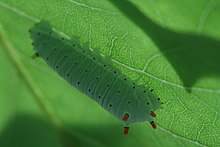Callosamia
| Callosamia | ||||||||||
|---|---|---|---|---|---|---|---|---|---|---|

Callosamia promethea , male |
||||||||||
| Systematics | ||||||||||
|
||||||||||
| Scientific name | ||||||||||
| Callosamia | ||||||||||
| Packard , 1864 |


Callosamia is a genus of butterflies from the family of peacock moth (Saturniidae). The Natural History Museum's Global Lepidoptera Names Indexlists three species in this genus. The species Callosamia promethea belonging to this genusisone of the best-known peacock spiders in North America,along with Hyalophora cecropia and Actias luna .
features
The moths have conspicuous angled discal spots , an irregularly undulating post-medial line and they lack the ante-medial line. They are colored in different shades of brown and have a pronounced sexual dimorphism . The simply feathery antennae and genitals are similar to those of the genus Hyalophora .
The caterpillars are about 60 millimeters long and in the fifth and last stage have two conspicuous pairs of unspecified processes (scoli) on the back of the thorax . These are red and, depending on the area of distribution, more or less surrounded by yellow and black at the base. In the middle of the back of the eighth abdominal segment there is another, single, yellow-colored scolus. With the exception of Callosamia promethea, there are also rows of small black tubercles on the side of the body, which are reduced to smooth bumps.
Occurrence
The genus is common in the eastern United States of America.
Way of life
The males react to the pheromones of all their related females, which is why it can be assumed that these differ chemically only slightly, if at all. There are also natural hybrids between Callosamia angulifera and Callosamia promethea . However, this is very rare, which is illustrated by only two individual finds from Illinois and Ohio. Hybrids grown in the laboratory are underdeveloped and unable to reproduce. However, the flight times of the three species differ significantly, which in spite of all this ensures good isolation of the three species. With Callosamia securifera mating takes place at noon, with Callosamia promethea in the afternoon and with Callosamia angulifera in the evening.
development
The females lay their small, white eggs in short rows of four to ten on the upper side of the leaves of the host plants. Initially, the caterpillars stay gregarious, close together and eat at the same time. Older caterpillars live solitary. The development takes place in all types of magnolia family (Magnoliaceae), whereby Callosamia promethea eats differently than the almost monophageous other species on a number of species from this and other plant families. The caterpillars go through five stages. The wintering takes place as a pupa . The cocoon is double-walled and has a hatch opening. The cocoons differ significantly between the three species in terms of size, shape, color and how they are attached to the food plant. In the north of the range the moths fly in one generation, in the middle of the range in two generations and Callosamia securifera in the extreme south in three generations per year.
Taxonomy and systematics
The genus was considered by Charles Duncan Michener as a subgenus of Hyalophora , as there are several morphological similarities between the moths. Since the pre-imaginal stages and the way of life differ greatly, Alexander Douglas Campbell Ferguson separated the group again as an independent genus. This view is shared by Tuskes & Collins.
The Natural History Museum's Global Lepidoptera Names Index lists the following species in the genus:
- Callosamia promethea (Drury, 1773)
- Callosamia angulifera (Walker, 1855)
- Callosamia securifera (Maassen & Weymer, 1873)
supporting documents
Individual evidence
- ↑ a b The Global Lepidoptera Names Index - Callosamia ( page no longer available , search in web archives ) Info: The link was automatically marked as defective. Please check the link according to the instructions and then remove this notice.
- ↑ a b c d e f g P. M. Tuskes, JP Tuttle, MM Collins: The Wild Silkmoths of North America. A Natural History of the Saturniidae of the United States and Canada . Ed .: George C. Eickwort. 1st edition. Cornell University Press, Ithaca / London 1996, ISBN 0-8014-3130-1 , pp. 194 (English).
literature
- PM Tuskes, JP Tuttle, MM Collins: The Wild Silkmoths of North America. A Natural History of the Saturniidae of the United States and Canada . Ed .: George C. Eickwort. 1st edition. Cornell University Press, Ithaca / London 1996, ISBN 0-8014-3130-1 (English).
Web links
- Lepidoptera and some other lifeforms (English)
